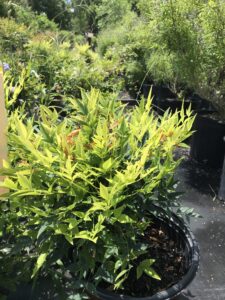Nandina domestica, Friend or Foe
for the North Florida Landscape?
Let me just start off by saying not all Nandina are created equal. No need to panic that birds are dying and forests are being invaded because you purchased Nandina domestica plants for your landscape. Most of todays modern Hybrids are sterile. Yep, thats right, STERILE. They simply don’t produce berries!
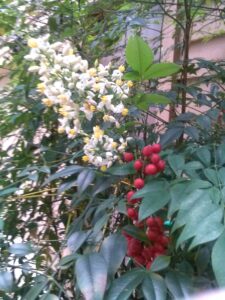
Nandina domestica was brought over as a prized ornamental plant in the 1800s from India and East Asia and has the common name of Heavenly bamboo, and it is easy to see why, with their bright red new growth, lacy foliage and beautiful bloom and berry clusters that hang on the branches like clusters of grapes, they are truly a sight to behold. While the beautiful berry clusters of yesteryears Nandina plants were the main attraction, they were easy on the eye and tough on our natural environment.
One alarming find from an article written by the Audobon Society based on a case in Georgia where Cedar waxwings found dead in a garden had stuffed themselves with Nandina berries and died from it. After studying the wild birds found dead with Nandina berries in them at the College of Veterinary Medicine at the University of Georgia, Nandina berries were found to contain small amounts of cyanide (similar to what may be found in apple seeds) and other compounds that mix to create a deadly Hydrogen Cyanide capable of quickly killing a bird that ate allot of them and would be typical of the feeding behavior of the Cedar Waxwing. Although I have not dedicated but a few hours of time to it I am unable to find any published cases of poisoning but that one finding from April of 2009.
Here is a link for the 2009 case of Cedar Waxwing poisoning
https://www.ncbi.nlm.nih.gov/pmc/articles/PMC3005831/
Heres a link to help with the understanding of the eating habits of Cedar Waxwings causing them problems with many things other than Nandinas. Yet there seems to be no Audobon articles and warnings on blueberries being toxic to birds. 🙂
https://www.facebook.com/groups/GardenProfessors/permalink/10157407758846490/
Other articles seem to indicate that ornithologists seem to think that most birds instinctively avoid the berries and may eat them in a famine situation or as a part of a normal varied diet , where they would have much more than just Nandina berries in their stomachs at a time like the cedar waxwings did. In fact, until that finding nandina domestica was touted as a good source for food for the birds. There is another short article online that states that Ornithologists at Cornell University believe that most birds regurgitate the berries instead of process them, although I can not find that published either.
The other problem is that the seeds within those berries germinated easily to be distributed in our forested areas where they displaced the native vegetation that our wildlife relies on. Hwever it is that those seeds get from landscaped gardens to forested areas may not be nearly as important as the fact that the science indicates they definitely do make the jump and do not confine themselves to the gardens they were planted in!
Nandina Domestica has been classified as a Category 1 invasive for Central and North Florida meaning that they have been assessed and found to be “altering native plant communities by displacing native species, changing community structures of ecological functions, or hybridizing with natives.” That means, for us Here in Northeast Florida, it may just be time for those Nandina to go. If you like me are reluctant to rid yourself of heirloom plantings, you may always choose to grow them indoors in a bright sunny window or simply be diligent about removing the flower and berry clusters but with so many new wonderful cultivars out that don’t produce berries, hopefully I can tempt you into falling in love with one or two of those instead. After all, less fuss equals more garden enjoyment right?
Although I do feel it is time for us in Florida to be in the process of getting rid of those Heirloom Nandina plants, thankfully there are many new cultivars created over the last 10 years or so that are sterile to tempt you with. These new modern hybrid cultivars of Nandina domestica won’t spread into our native forested areas and don’t produce berries at all. These modern hybrids are not your mothers Nandina plants and can safely be planted in our home landscapes. In fact, they make excellent plants that require little to no trimming, minimal if any fertilizer required to keep them healthy and thriving and come in a variety of color combinations.
These new hybrids more than make up for the loss of those beautiful berry clusters with colors that change with the seasons. I have had the cultivar “Firepower” in my home landscape for more than 10 years and never had to so much as trim them once. I doubt I have even given tehm any fertilizer more than a handful of times if even that often. They jsut never seem to need any help from me! They just sit quietly doing their job in the landscape never giving me a moments worry while other plants around them get all the fussing over. For todays modern and very busy homeowner nandina domestica hybrids are truly an excellent plant choice.
Check out the selections below to find your perfect fit.
S & J Nursery’s
“Not Your Momas Nandina”
Sterile or Florida Friendly
Nandina domestica
Selections for Northeast
Florida Jacksonville|St. Augustine Gardens
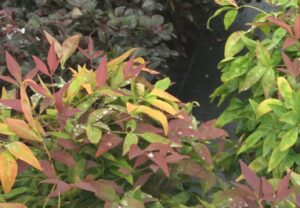
Nandina Pink Blush
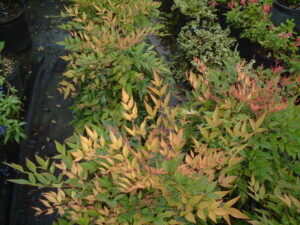
Nandina Gulf Stream
( May occaisionally produce flowers or fruit in our climate with low viability, may be best to remove any berries if your plants do produce them)
Harbour Bell
( not currently available, as I don’t have a supplier that grows this selection)
Nandina Harbour Dwarf
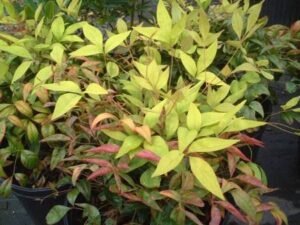
Nandina Dwarf Firepower
Nandina Flirt
